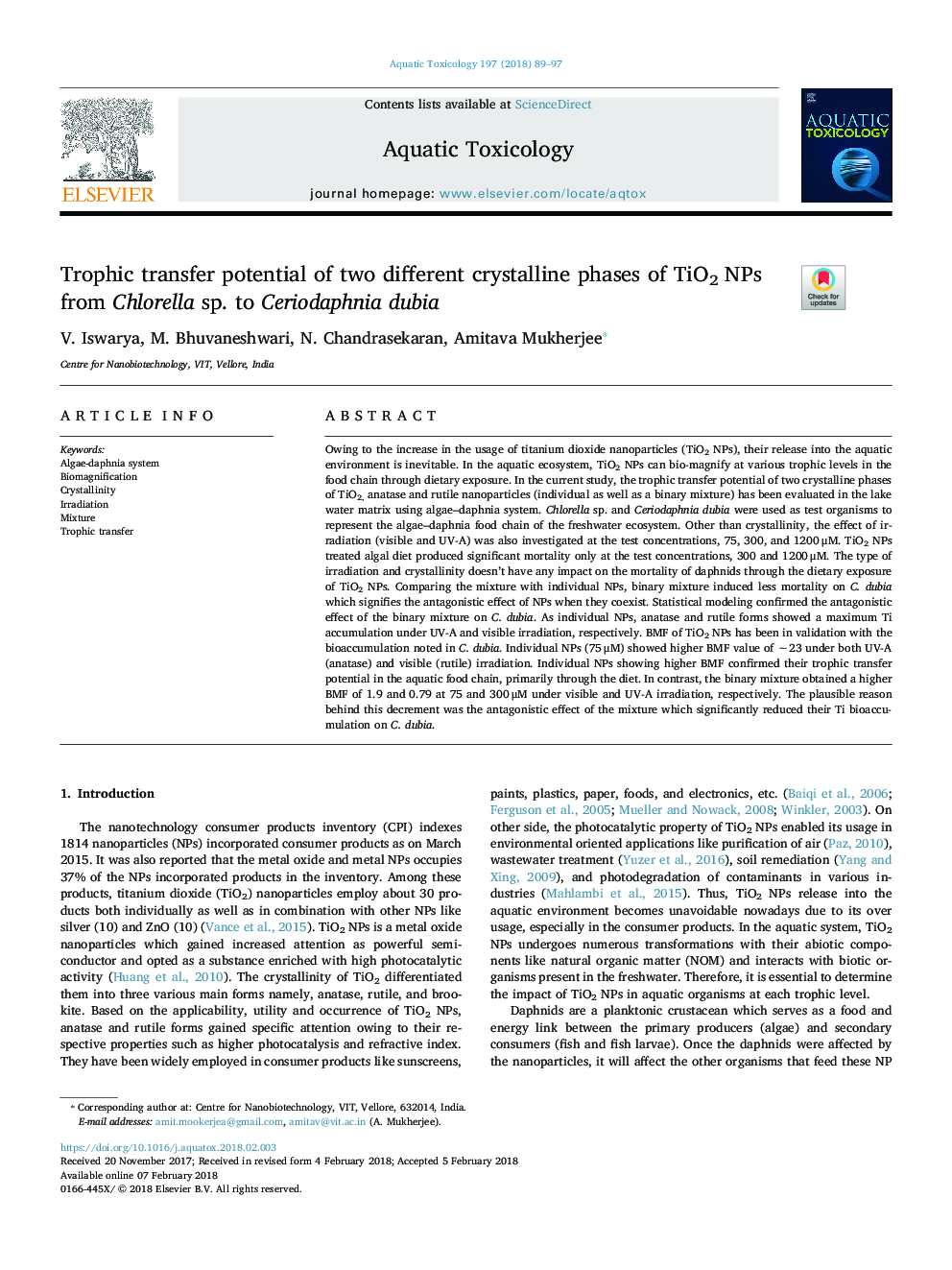| کد مقاله | کد نشریه | سال انتشار | مقاله انگلیسی | نسخه تمام متن |
|---|---|---|---|---|
| 8883818 | 1625908 | 2018 | 9 صفحه PDF | دانلود رایگان |
عنوان انگلیسی مقاله ISI
Trophic transfer potential of two different crystalline phases of TiO2 NPs from Chlorella sp. to Ceriodaphnia dubia
دانلود مقاله + سفارش ترجمه
دانلود مقاله ISI انگلیسی
رایگان برای ایرانیان
کلمات کلیدی
موضوعات مرتبط
علوم زیستی و بیوفناوری
علوم کشاورزی و بیولوژیک
علوم آبزیان
پیش نمایش صفحه اول مقاله

چکیده انگلیسی
Owing to the increase in the usage of titanium dioxide nanoparticles (TiO2 NPs), their release into the aquatic environment is inevitable. In the aquatic ecosystem, TiO2 NPs can bio-magnify at various trophic levels in the food chain through dietary exposure. In the current study, the trophic transfer potential of two crystalline phases of TiO2, anatase and rutile nanoparticles (individual as well as a binary mixture) has been evaluated in the lake water matrix using algae-daphnia system. Chlorella sp. and Ceriodaphnia dubia were used as test organisms to represent the algae-daphnia food chain of the freshwater ecosystem. Other than crystallinity, the effect of irradiation (visible and UV-A) was also investigated at the test concentrations, 75, 300, and 1200â¯Î¼M. TiO2 NPs treated algal diet produced significant mortality only at the test concentrations, 300 and 1200â¯Î¼M. The type of irradiation and crystallinity doesn't have any impact on the mortality of daphnids through the dietary exposure of TiO2 NPs. Comparing the mixture with individual NPs, binary mixture induced less mortality on C. dubia which signifies the antagonistic effect of NPs when they coexist. Statistical modeling confirmed the antagonistic effect of the binary mixture on C. dubia. As individual NPs, anatase and rutile forms showed a maximum Ti accumulation under UV-A and visible irradiation, respectively. BMF of TiO2 NPs has been in validation with the bioaccumulation noted in C. dubia. Individual NPs (75â¯Î¼M) showed higher BMF value of â¼23 under both UV-A (anatase) and visible (rutile) irradiation. Individual NPs showing higher BMF confirmed their trophic transfer potential in the aquatic food chain, primarily through the diet. In contrast, the binary mixture obtained a higher BMF of 1.9 and 0.79 at 75 and 300â¯Î¼M under visible and UV-A irradiation, respectively. The plausible reason behind this decrement was the antagonistic effect of the mixture which significantly reduced their Ti bioaccumulation on C. dubia.
ناشر
Database: Elsevier - ScienceDirect (ساینس دایرکت)
Journal: Aquatic Toxicology - Volume 197, April 2018, Pages 89-97
Journal: Aquatic Toxicology - Volume 197, April 2018, Pages 89-97
نویسندگان
V. Iswarya, M. Bhuvaneshwari, N. Chandrasekaran, Amitava Mukherjee,